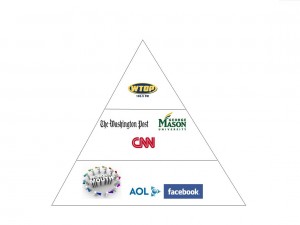Mandy Jenkins came to our Comm. 361 class to speak to us about an array of things concerning online journalism and the rise of social media. Jenkins works as a social media producer for TBD.
TBD is a local news website for the Virginia, Maryland, and Washington, D.C. area. It’s a wonderful news website that has a great tool called News Near You where you can type in your area code and get specific news correlated to where you live.
Jenkins, who is from a rural town in Ohio, explained how as soon as she was introduced to the web she was hooked. She became an addict and was always searching for more.
“Networking is all about building a relationship online,” – Jenkins
Jenkins personal blog helped her connect with people she knew who were doing the same thing. It helped her build a foundation to further her work.
She explained that her discovery of Twitter in 2007 lead her to making wonderful connections and relationships in her field of work. She actually ended up meeting her employer through Twitter. This just goes to show the power of social media.
Jenkins explained how it’s important not to ignore people’s comments and always try to respond to them. Whether they’re positive or negative.
“I always try and do my best to respond to everyone who writes to me, even if they didn’t have anything positive to say,” -Jenkins
Jenkins ended her presentation by giving the class some very helpful websites to utilize as online journalist. Here they are:
I thought her coming to class was very helpful and gave a good inside perspective to how social media is really the wave of the present.
Claudia Holland, GMU’s Copyright Officer, came to our Comm. 361 class to speak about copyright issues.
She explained how the three copyright traits are:
- Expression
- Originality
- Fixation
She then went on to explain and give examples of protected works and works not protected:
Protected works: Almost anything is a protected work.
- Literary
- Architectural
- Sounds recordings
- Motion pictures
- Graphics
- Plays
Works Not Protected:
- Ideas
- Basic facts
- Public domain
- Titles, names, short phrases, slogans
- Anything published prior to 1923
She then went on to explain that fair use was intended to benefit the public and that individuals can use these items without permission in certain circumstances. These factors are as followed:
- Purpose and character of the use
- Nature of the work
- Amount of substantially of the portion used
- Effect of the use on the potential market
A cool example she used was it dealing with a hit song. The lyricist and the composer actually own the rights to the song. With a hit song comes a bundle of rights such as:
- Reproduction: Cd’s, MP3s
- Derivative: Music videos
- Public distribution: Selling of Cd’s, MP3s, etc.
- Public performance: Concerts
- Public display: T-Shirts, bumper stickers
- Digital audio transmission: Podcasts
Holland ended her presentation by telling us about Creative Commons which is a website that “provides an infrastructure that consists of a set of copyright licenses and tools that create a balance inside the traditional “all rights reserved” setting that copyright law creates..” It’s basically a wonderful tool to use as an online journalist to make sure you’re not running into any trouble with copyrights.
Very helpful stuff that opened my eyes to a lot of useful information.

Above is my media pyramid. The items that are at the bottom of the pyramid are the places I get most of my news from. Word of mouth is definitely a big contributor as I’m surrounded by people everywhere I go. People are always talking about current events and that serves as a huge source of my information. Also, I log in to AOL mail everyday and there are always stories posted right at the log-in page. Another daily source of news. Then the very popular Facebook gives me tons of information with my friends status updates, news links, videos, and wall posts.
The middle part of my media pyramid includes The Washington Post, CNN, and George Mason University. My parents receive the post and I glance at the headlines every morning before leaving for the day. I receive CNN texts to my phone with breaking news, in which I tend to get on a weekly basis. Lastly, all the different media around campus serve as a big source of news.
The top part of my media pyramid has WTOP radio. I generally listen to my iPod in the car en route to my destinations, but will periodically tune in to WTOP for weather, traffic reports, and news.

